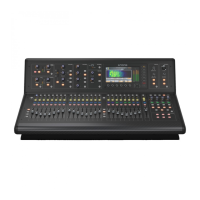Destination:
The patch connector to which a signal is routed.
See Patching.
Device:
A diagram(s) in the I/O tabs representing a physical
rack unit, such as a line I/O, mic splitter, DN9696, AES50 etc.
See Patching.
DI:
Abbreviation for ‘direct inject’ or ‘direct injection’. Signal is
plugged directly into the audio chain without using a microphone.
DI box:
Device for matching signal level impedance of a source
to mixer input.
Drag:
A method of GUI operation, mainly for control adjustment.
Also used for selecting blocks of patch connectors during patching.
DSP:
Abbreviation for ‘digital signal processing’ or ‘digital signal
processor’.
Any signal processing done after an analogue audio signal has been
converted into digital audio. Can be used to create, for example,
compression, equalisation etc., of a digital signal. A digital signal
processor is a piece of equipment specifically designed for carrying
out signal processing.
E
E zone:
Section in the input channel strip for controlling EQ
parameters.
Effect:
One of a number of audio processes that can be applied
to a signal to modify it, such as reverb, flanging, phasing, delay
etc.
Effects rack:
A virtual rack of internal processors. See Virtual
rack.
Envelope:
1. How a sound or audio signal varies in intensity over
time.
2.
The visual representation of such, usually shown on a
graph in a GUI channel strip.
EQ:
Abbreviation for ‘equaliser’ or ‘equalisation’.
Equalisation:
Adjusting the frequency response so
that the levels of all frequencies are equal or the
same. Bass and treble controls are equalisation
controls.
EtherCon®:
A cable connector for data transfer interconnections,
which is more robust than the basic RJ45.
F
Fader:
Slider-type device for precise adjustment of signal level
or volume of a channel.
Fast strip:
One of the strips in the input, mix and output fast
zones. See Input fast strip, Mix fast strip, Output fast strip and
Fast zone.
Fast zone:
An area on a bay that contains quick controls. See
Input fast zone, Mix fast zone, Output fast zone and Fast strip.
FB:
Abbreviation for ‘front-back’. A term used in surround panning.
Feedback:
See Acoustic feedback.
Filter:
A device for removing frequencies above or below certain
levels.
FOH:
Abbreviation for ‘front of house’. The area in a theatre used
by the public. Used to describe a control centre being used to
control the sound that the audience will hear (and not the
performers’ monitor system).
Frequency:
The number of times that a sound wave’s cycle
repeats within one second.
Fricative:
A consonant, such as ‘f’ or ‘s’, produced by the
forcing of breath through a constricted passage.
From section:
The leftmost area of the patching screen that contains the
source patch connectors. See Patching.
G
Gain:
Another term for signal level.
Gain reduction (compressor):
Decrease in gain when input signal is above
threshold. See Gain.
GEQ:
Abbreviation for ‘graphic equaliser’. See Graphic EQ.
GEQ rack:
A virtual rack of GEQs. See Virtual rack.
Granularity:
A measure of the size of components or a description of the
components comprising a system.

